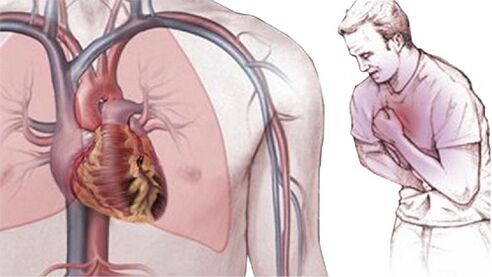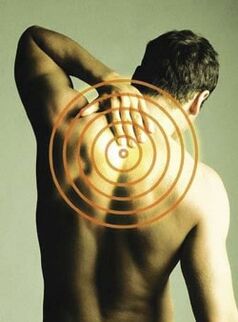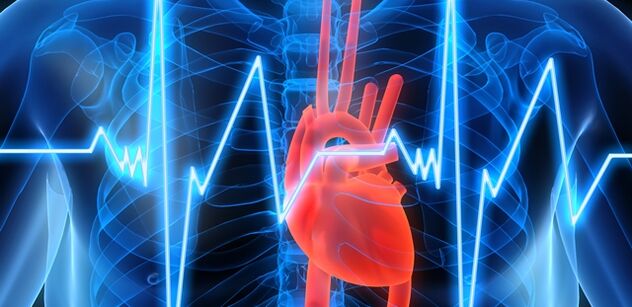
It happens when a person visits a doctor with a heart complaint. The specialist sent him for an examination, but it did not reveal the pathology. It would be good for a cardiologist to suggest consulting a neurologist. In this case, he may report that the cause is not heart disease but osteonecrosis.
It turns out that one of the symptoms of thoracic osteosarcoma is pain in the mammary glands or the heart. It can be pulled, sore, and pressed. In some cases, there is a burning sensation in the chest area and rhythm disturbances. Over time, the pain can get worse. In this case, heart medications do not help.
Features of heart attack in osteonecrosis
Many people have a question: is heart disease painful? Right. Patients often complain of the following:
- Persistent heart and chest pain.
- Gradually, there are pains in the heart with osteonecrosis.
- Pain is very boring and pressing.
- The intensity of pain in the sternum is low.
- Reception of nitrates does not help to eliminate pain in the chest.
- Patients try to do less movement with their upper extremities, resulting in increased pain sensations.
Sometimes cervical and thoracic osteonecrosis occurs at the same time, in this case, pain is also present in the neck. Patients may complain of the following:
- Pain in the shoulders, face and neck.
- Discomfort extends to almost the entire upper chest area, affecting the muscular tissues of the spine.
- An attack can last several hours or even days.
Sometimes the cause of the pain is reflected in the compression of the vertebral artery. In this case, the following symptoms appear:
- dizzy;
- hearing and vision impairment;
- pain in the back of the head;
- antihypertensive drugs do not give the desired effect;
- feeling of weakness;
- shortness of breath;
- loss of consciousness;
- blood rushing to his face.
The symptoms of osteonecrosis of the spine and the way a heart attack occurs in women and men are not different.
What are the effects of osteonecrosis on the heart? This disease is accompanied by changes in the spine, especially in the region of the spinous process of the lower cervical vertebrae. Weakness in the little finger and decreased strength of the muscles in the left hand may be felt.
How to distinguish a heart attack from osteonecrosis?

How to recognize: is it pain due to pathology of the heart or osteonecrosis? Solving the problem is not simple: in each case, the cells can give off sharp, painful pains, and with exertion, the discomfort increases.
Although it is quite difficult to distinguish angina from thoracic osteodystrophy, there are signs that will help determine the true cause of the pain.
Heart attack differences in osteonecrosis:
- Duration of pain: they last for weeks, months.
- Seizures occur with sudden elevation of the arm and head, tilting and turning, as well as coughing.
- The pain may subside and subside when the body is in a comfortable position.
- With many ECG violations are not detected.
- When tilting the chin to the chest, the pain is more intense, this is a sign of a herniated disc.
- With pain, there is no onslaught of anxiety and fear.
- Staying in one position for long periods of time (eg, during sleep) can lead to pain in the heart.
- Glycerol trinitrate doesn't help with pain, so just use a pain reliever.
- Heart attack in osteosarcoma with a sharp change in the position of the body immediately increases, they occur with sneezing, coughing, deep breathing and sudden head movements.
- When exposed to the spine, the intensity of pain increases.
- Chest pain with bone necrosis is not life-threatening.
Now let's see how to determine what causes a heart attack with angina. In this case, there will be such pains:
- short time;
- does not involve physical activity;
- heart medicine that helps prevent or relieve pain;
- pain sensation does not change if the load on the spine remains constant;
- pain of the same intensity;
- pain radiating down the arm, jaw, and under the left shoulder blade;
- pain can be caused by excessive nervous tension;
- electrocardiogram reflects the presence of pathologies;
- the patient has a fear of death;
- may cause the patient to die.
The nature of pain in osteonecrosis

Many people are interested in how much the heart hurts with osteonecrosis. Discomfort not only in the chest but also in the upper abdomen, in the ribs and near the spine. Movements are limited when staying in one position for long periods of time, while the pain is increasing. A short walk will help you get rid of the discomfort.
In addition, there may be back and shoulder pain. It can get worse when you take a deep breath. The degree of discomfort is influenced by temperature (decreased) and changes in barometric pressure.
Bone tumors and heart attacks are aggravated by rotation of the torso. This is due to an increased load on the anterior vertebral disc. Often there is a syndrome in this area. Inhalation may cause pain in the intercostal region. Back strain may occur, accompanied by unilateral spasm.
Sometimes the heart is in pain due to bone necrosis so there seems to be a problem in the organs in the chest cavity. The disease can masquerade as intestinal and stomach pain, and in some cases, can even resemble appendicitis. If no action is taken, osteonecrosis not only spreads to the heart, but also causes respiratory, cardiovascular and gastrointestinal diseases.
The nature of the pain can vary. The exacerbation can be replaced by remission, which occurs in waves.
Causes of heart attack due to bone necrosis

Distinguishing a heart attack from osteonecrosis is not always easy. In the human body, there is a complex system of transmitting impulses from various systems and organs to the brain and vice versa. This allows him to collect information about all systems and manage their work. As a result, a connection is formed between the nerve endings and the spinal cord, located in the spine. When they are violated, the transmission of impulses occurs with a violation, the brain reacts incorrectly, pain appears to spread to the chest and heart area.
Heart attack due to osteonecrosis occurs in the following sequence:
- Changes that occur in the spine due to trauma.
- The disc protrudes outward, which does not affect the bulging annulus.
- In the event of rupture of the annulus, the central cartilaginous nucleus enters the brain canal leading to herniation.
- bone is formed.
- The vessels and nerves surrounding the disc begin to flatten.
- Presence of pain syndrome.
With osteosarcoma, the heart rate may become more frequent and tachycardia may appear. Spinal injuries in different areas can give different pain symptoms. Nerve pain is affected by the extent of the damage:
- only the vertebral body;
- disc;
- ligament apparatus;
- vertebral body.
How does osteosarcoma affect heart function? After deforming, the discs compress the nerves of the spine. This leads to pain. Osteochondrosis can not only cause the heart, but also cause pathologies of the entire spine. The disease can spread to neighboring departments leading to the appearance of new symptoms.
Heart pain symptoms with osteonecrosis
Signs and symptoms of osteonecrosis with cardiac pain usually occur on the basis of a perfectly healthy cardiac system. Usually they are stable, but may present and increase paroxysms. In the case of problems with the spine, the pains are boring, deep and dramatic, their characteristic is an unshakable severity. When there is pain in the chest area due to osteonecrosis, glycerol trinitrate does not help, because the cause is not in the heart.
To distinguish heart pain from thoracic osteonecrosis, it is important to know that sensations of a different nature can occur. For example, they can spread from the affected area to the muscles of the anterior part of the chest, which connect the cervical roots from the fifth to seventh. In this case, you may feel pain in the upper left area of the body, sometimes even affecting part of the face. At the same time, vascular disorders are not diagnosed, the electrocardiogram does not detect abnormalities. This happens even at the peak of the pain.
How does thoracic osteonecrosis affect the heart and human body?

One of the manifestations of osteonecrosis is compression or compression of blood vessels. This leads to narrowing of the "channels" through which blood travels. In order for the organs to continue to receive it in the proper amounts, the heart has to work harder. This means that the number of contractions increases every minute. As a result, blood pressure increases. This is the effect of bone resorption on the heart.
Violation in the work of the circulatory system leads to the occurrence of pain in the heart with osteonecrosis of the chest and oxygen starvation of the brain. As a result, the above symptoms occur. Reaction, thought speed, emotional state, spatial orientation and memory depend on heart activity, as well as vision or hearing problems.
Because of all these consequences, it is difficult to determine whether the heart is in pain or if it is thoracic osteonecrosis.
Diagnose
How is it determined that the heart is in pain due to osteonecrosis? There are special procedures that will help determine the form and extent of the disease. When the disease is more severe, it is better to consult a doctor. Doctors may recommend performing a differential diagnosis, which allows you to determine what the cause of the disease is - heart or spine. It may include the following procedures:
- ECG. When recording electrocardiogram will immediately identify heart disease. If the results are normal, it is clear that the cause of the pain is nerve pain or bone necrosis.
Electrocardiogram is a mandatory diagnostic procedure for the formation of pain in the chest.
- supersonic. It is done for patients with suspected infectious lesions of the heart. It is used as a complementary method.
- X-ray. X-rays are indicated for patients with suspected osteonecrosis. Imaging will allow to determine the destructive destruction of the joints. With heart problems, they won't.
- CT and MRI. They can help if the x-ray is inconclusive. These methods will more accurately identify the lesion. Magnetic resonance imaging will help diagnose osteonecrosis and heart disease.
The treatment
Rest and bed rest will help reduce the pain of osteoarthritis. The surface should not be soft or hard. The pillow is chosen so that the neck is not bent. You can reduce the pain if you put a heating pad that is not too hot underneath.
Treatment of thoracic osteonecrosis is carried out by the following methods:
- Medicine:
- vasodilators;
- psychotropic drugs;
- diuretic;
- analgesic;
- non-steroidal anti-inflammatory drugs;
- chondroprotectors;
- sedative.
- Physical therapy. The patient will undergo procedures in which the damaged area is acted upon by an electric field and an electric current of varying frequency. This will help initiate the natural tissue regeneration mechanism.
- The use of turpentine, ointments containing snake or bee venom, as well as analgesics. They trigger the release of heat in the muscles, improve the condition of the nerve roots, dilate blood vessels.
- Acupuncture. With the help of needles, energy meridians and active points are affected.
- Manual therapy. Thanks to them, the degenerative process in the spine is adjusted and acts on the disc joints.
- Back massage will not allow you to get the desired effect. The muscles are located around the vertebral discs, it is almost impossible to reach them. The effect brings a special acupressure and deep massage effect. Before this procedure, you should take pain medication.
- At home, you can use warm heating pads and warm compresses to reduce muscle tone.
Manual therapy and reflexology should only be performed by a qualified chiropractor, neurologist or traumatologist who has undergone special training and received the appropriate certification.
Taking heart medication is often the first and most powerful treatment for an illness. When used with other methods, results can be greatly improved. Armed with the knowledge, it's time to start treatment!
self-treatment mistakes
Often, patients who complain of thoracic spine disease make a serious mistake in self-treatment - they take the drug if there are contraindications. For example, the older generation prefers to use NSAIDs from the group of phenylacetic acid derivatives. However, it cannot be used for problems with the stomach lining. They are usually intended for people over the age of 50.
So, we looked at the differences and differences between the symptoms of angina and osteonecrosis, and familiarized ourselves with the methods of diagnosis and treatment. Cooperate with qualified doctors and follow their instructions. Be patient and consistent, you will overcome this dangerous and painful disease! Remember, it can be very dangerous. So much so that the patient can be discharged.


































